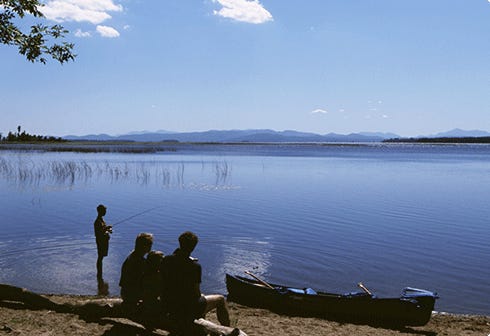Hug a Hunter?
How hunters support environmental conservation in America
I went for a hike recently at one of Vermont’s 103 wildlife management areas (WMAs). I parked my truck and noticed a small kiosk with a map and some other signage, including this logo:
This is the Federal Wildlife and Sport Fish Restoration (WSFR) Program logo. WSFR is responsible for distributing millions of dollars for wildlife and land conservation purposes throughout the United States. The WMA I explored that day had been acquired by the state of Vermont with funds from the WSFR; its ongoing management is also made possible because of this funding source. This property and hundreds of other state-owned lands are also purchased and supported with funds from the WSFR Program. As a result of this funding, there are ample opportunities for the public to explore wild spaces…not just in Vermont but throughout the country.
Finding Common Ground
A few recent articles have made me think about the tensions between hunter, angler, and trapper communities and those who oppose these activities. Where I live in Vermont, there has been abundant press over the past couple of years about trapping regulations, bear hound hunting, and initiatives to change how fish and game rules get created in the state. As you can imagine, both sides of this debate are passionate.
Sandbar Wildlife Management Area (WMA). Photo Source: VT Agency of Natural Resources
Wildlife biologists and many hunters will tell you that hunting and trapping are needed to manage multiple species successfully. We have reached a point in ecosystem management where active management, including population regulation with hunting and trapping, is both necessary and humane because to stop now would result in overpopulation, starvation, suffering, and imbalance in both plant and animal communities.
Like any politicized debate, the most visible examples cited are extreme cases that are the most eye-popping: the GPS-collard bear hounds that trespass while an entitled land-owner screams at them (and subsequently posts their property); the tragic story of a person’s pet dog that ended up dying from a leg-hold trap; examples of animal cruelty where hunters don’t adhere to fundamental principles of fair chase and ethics. Some want to ban trapping altogether, or those who find all hunting inhumane, no matter what. I find such extremism unproductive in trying to understand another person’s viewpoint. Too often, the outcomes of these impassioned conversations are predetermined since the participants’ worldviews have become so entrenched that considering anyone else’s viewpoint is impossible.
There is in fact an 80-year-old law that highlights a nexus between two communities of outdoor recreators (hunters and non-hunters) who increasingly seem to be at odds despite a common interest in public lands and sustainable stewardship.
Beaver photo courtesy of Vermont Fish & Wildlife Department
Federal Restoration Act
The Wildlife and Sport Fish Restoration (WSFR) Program receives funding from the Pittman-Roberston Act of 1937 (aka the Federal Restoration Act), which created an 11% federal excise tax on firearms and ammunition; these funds get redistributed to states based on the number of hunting and fishing licenses sold. (The 1950 Dingell-Johnson Act is the law that imposes an excise tax on fishing gear, pleasure boats, and gasoline for motorboats, the proceeds of which go into the WSFR).
There are some parameters on how states use this money. States must spend cash on conservation and hunter education; it cannot go into a state’s general fund. Access to Federal Restoration Act cash is contingent upon states guaranteeing that hunting and fishing license sale proceeds go to fish and game departments (not the state’s general funds).
Land conserved as WMA. Source: Vermont Fish & Wildlife Department
For the 2023 fiscal year, VT received just over $7 million from the Pittman-Robertson Act, equaling about 0.6% of all funds administered nationally. Vermont’s Department of Fish and Wildlife budget in 2024 was $29.4 million, meaning that approximately a quarter of the Department’s budget comes from taxes paid on the sale of guns, ammo, archery equipment, and fishing gear. Another $10.2 million comes from fishing and hunting license fees, which are required to stay within the Department, thanks to Pittman-Robertson.
Image source: Sports Afield
Everyone’s Land
Since the Department of Fish and Wildlife does much more than just manage hunting and fishing (such as land conservation), people buying guns and ammo and hunting & fishing licenses contribute a lot of money to land conservation and wildlife management. Various PR efforts have highlighted this connection, such as Colorado’s Hug a Hunter campaign. These lands are open to everyone, and I’m sure many non-hunters and anti-hunters regularly use conserved land and waterways that exist because of the Pittman-Robertson Act.
Click here to find out more about Vermont’s WMAs.







